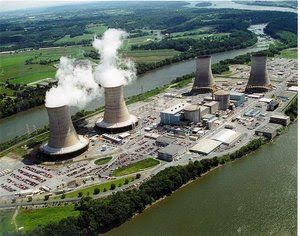"France initially followed the UK's lead by building reactors similar to the Magnox design during the 1960s. Meanwhile, the US realized that the most economical reactors are those that are collectively referred to as light-water reactors (LWRs).
"LWRs use ordinary water as a moderator and as a coolant, running on uranium-oxide fuel enriched with up to 5% uranium-235 and contained in a zirconium alloy cladding." (Physics World, July 2007).
 "The core temperature rose to the point at which the zirconium alloy cladding began to react with steam to produce hydrogen, some of which escaped into the reactor building. Early in the afternoon of the first day, sufficient hydrogen had accumulated in the reactor building to result in a low-level explosion." (Environmental Radioactivity, Eisenbud, p370-371).
"The core temperature rose to the point at which the zirconium alloy cladding began to react with steam to produce hydrogen, some of which escaped into the reactor building. Early in the afternoon of the first day, sufficient hydrogen had accumulated in the reactor building to result in a low-level explosion." (Environmental Radioactivity, Eisenbud, p370-371).Three Mile Island, March 1979.
 "Two explosions occurred at 01:24. The steam released by the failure of one or more pressurized tubes had reacted exothermally with the zirconium, producing hydrogen that exploded. Parts of the core were scattered about the building as well as on the roofs of the reactor, turbine, and auxiliary buildings." (ibid, p378).
"Two explosions occurred at 01:24. The steam released by the failure of one or more pressurized tubes had reacted exothermally with the zirconium, producing hydrogen that exploded. Parts of the core were scattered about the building as well as on the roofs of the reactor, turbine, and auxiliary buildings." (ibid, p378).Chernobyl, April 1986.
 "The cladding, which is just the outside of the tube, at a high enough temperature interacts with the water. It's essentially a high-speed rusting, where the zirconium becomes zirconium oxide and the hydrogen is set free. And hydrogen at the right concentration in an atmosphere is either flammable or explosive.
"The cladding, which is just the outside of the tube, at a high enough temperature interacts with the water. It's essentially a high-speed rusting, where the zirconium becomes zirconium oxide and the hydrogen is set free. And hydrogen at the right concentration in an atmosphere is either flammable or explosive."Hydrogen combustion would not occur necessarily in the containment building, which is inert—it doesn't have any oxygen—but they have had to vent the containment, because this pressure is building up from all this steam. And so the hydrogen is being vented with the steam and it's entering some area, some building, where there is oxygen, and that's where the explosion took place."
Fukushima, March 2011.

3 comments:
Lessons from history number 1: do NOT use zirconium alloy to clad your reactor rods.
My newspaper had a nice article about reactor design. It was about technological lock-in. Apparently, there are many types of reactors, like heavywater reactors and gas cooled reactors that don't melt down as soon as the cooling water stops pumping, but we stick with lightwater anyway. Why? Because the first power plant was a lightwater reactor in the USS Nautilus, because it was the design easiest to miniaturize. They didn't want to reinvent the reactor for commercial plants, so we stuck with that design and kept refining it.
Interesting.
This comes from the Physics World article:
"Many of the advantages of LWRs stem from their very compact reactor cores, which are possible because water is the most effective of all commonly used moderators at slowing down fission neutrons. This makes LWRs more economical and much easier to build and operate than Magnox and AGR plants (although the latter do not require such high levels of uranium enrichment). For example, the pressure vessel in which the reactor is contained plus all the surrounding structures are small enough to be built in a factory and transported to site, whereas Magnox and AGR pressure vessels are so big that on-site construction is required.
"Although the UK had designed AGRs to be competitive with LWRs, which they almost were, the design ended up being slightly more expensive to build and operate than LWRs. Combined with their slightly worse operational performance, the competition from LWRs was too much in the end – a bit like Boeing versus the small UK aircraft manufacturers."
Post a Comment